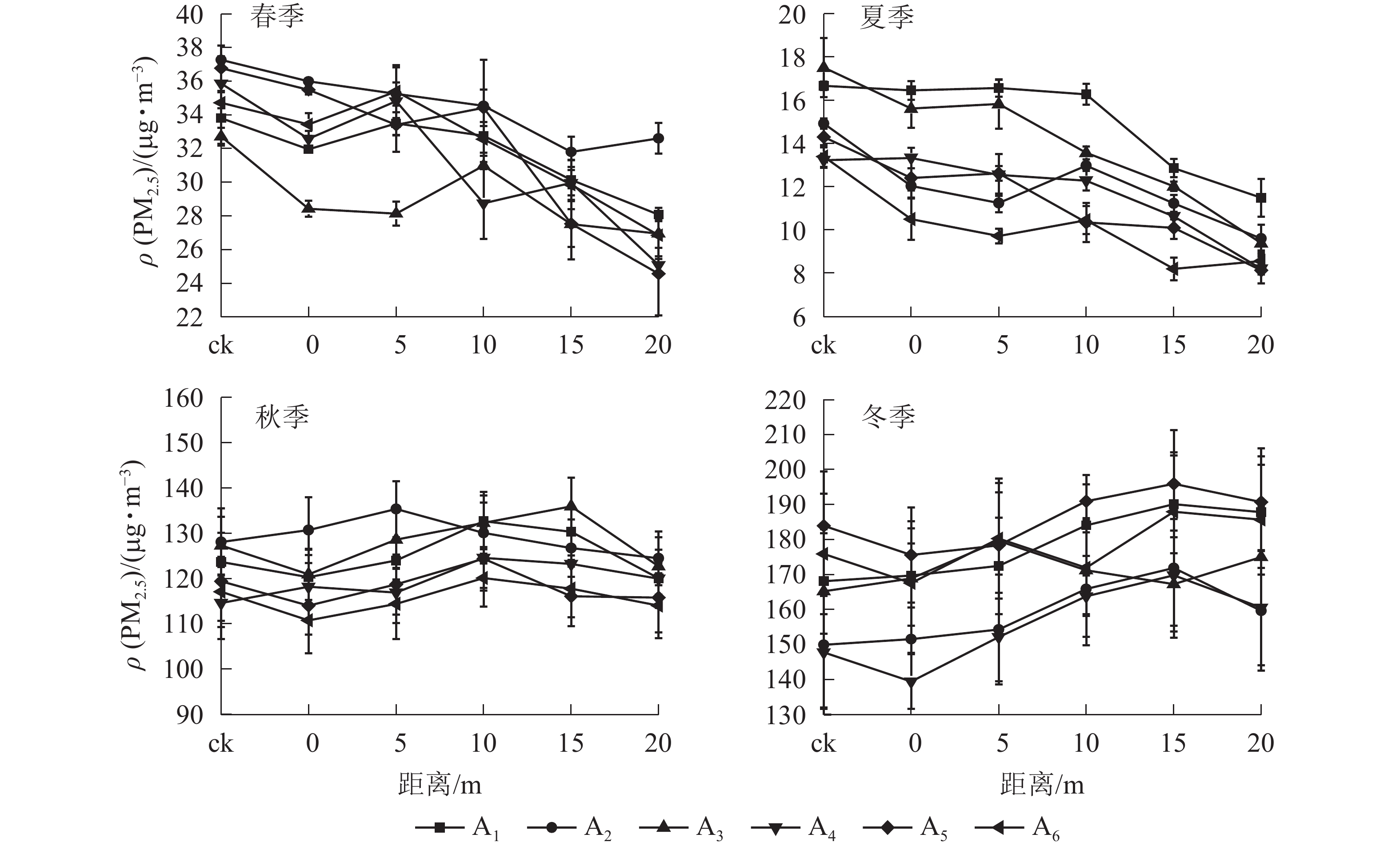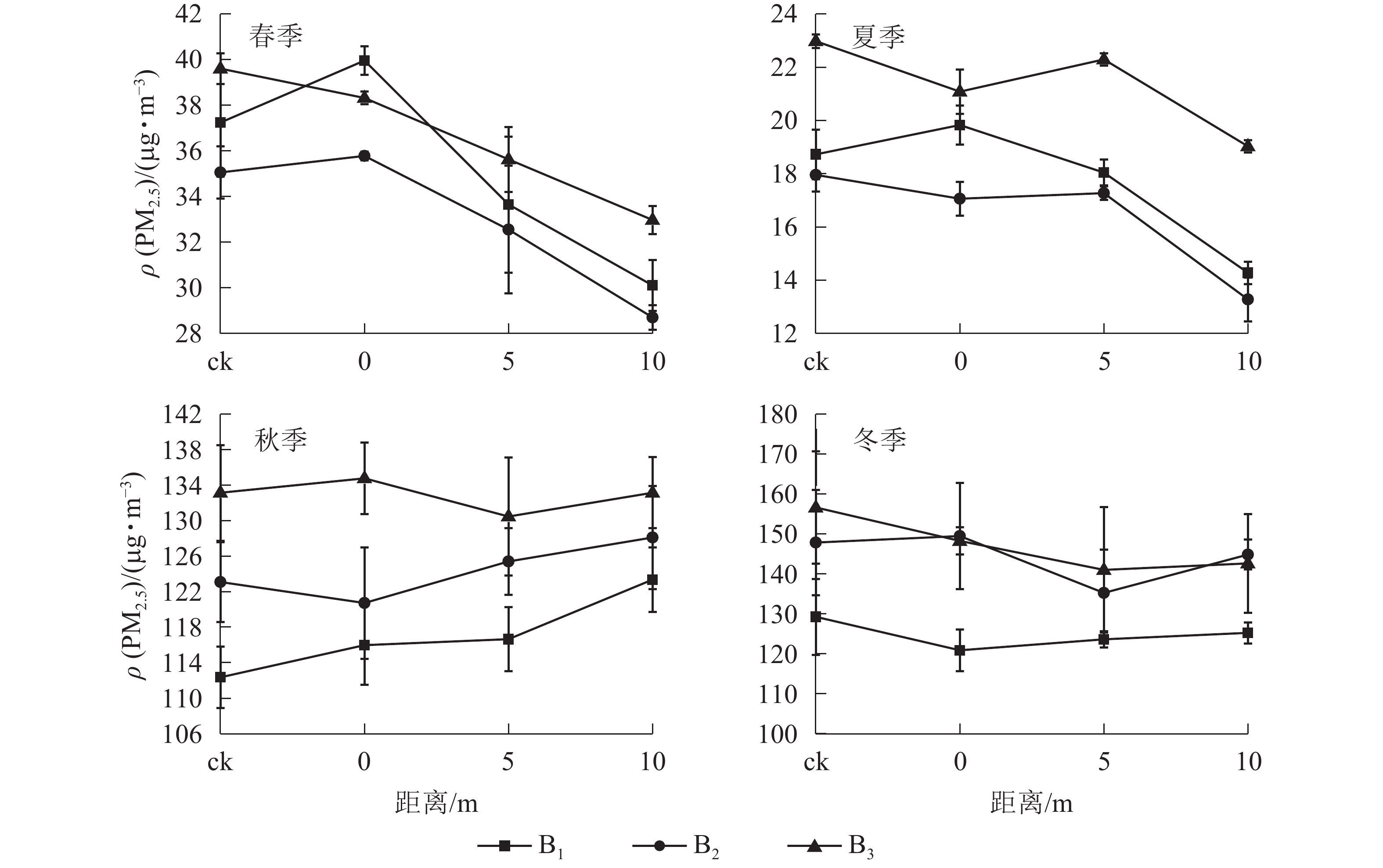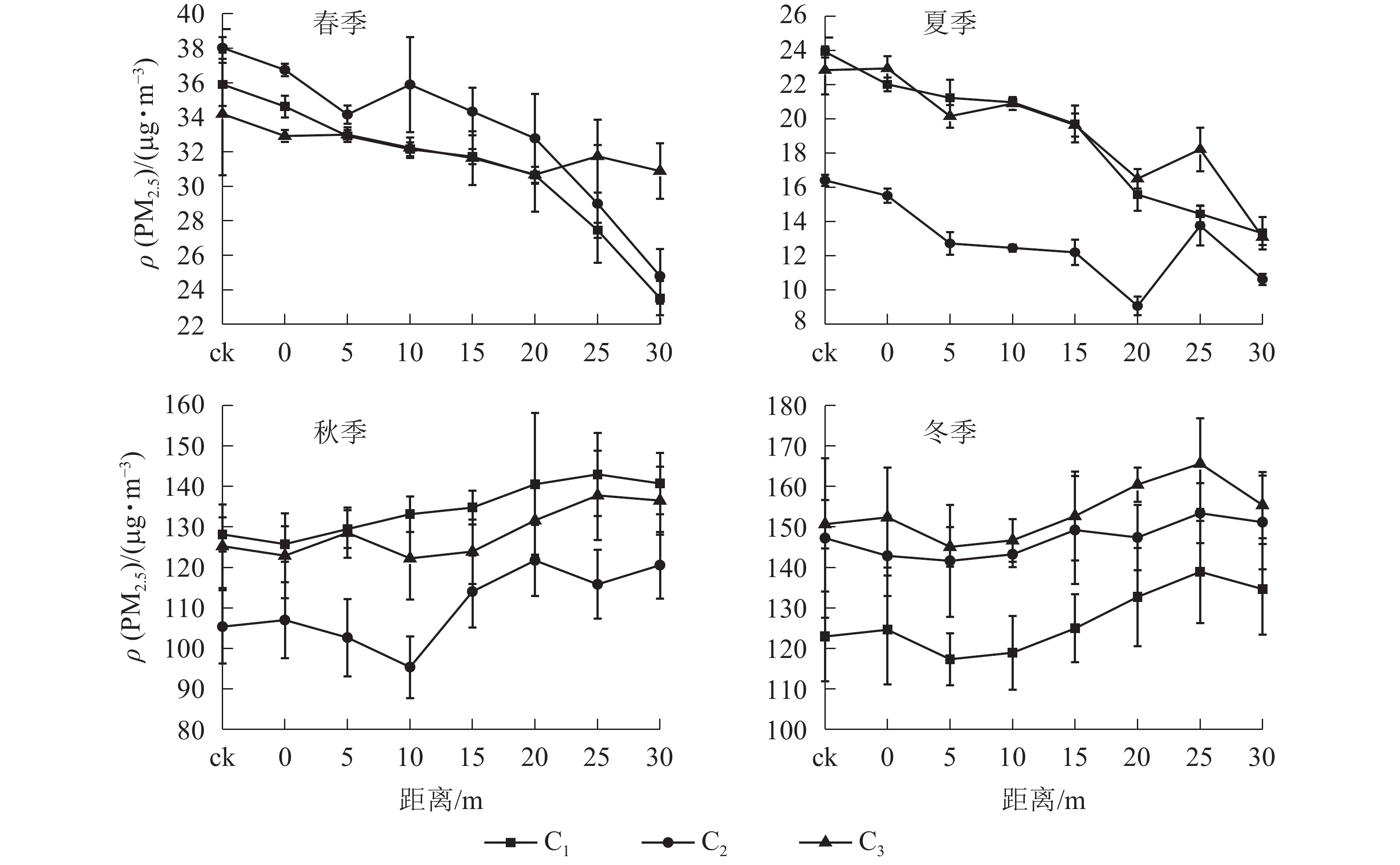-
有研究表明,植物的叶表面结构和生理生化特性对细颗粒物(PM2.5)有吸附和净化作用,植物类型不同其所发挥的效果也不同[1-2]。目前,国内外学者针对PM2.5的详细研究主要包括其组成来源[3-4]、化学组成分析[5-6]、去除途径等方面[7];有关城市森林对PM2.5的阻滞作用研究也多有涉及,尤其是不同配置模式的城市绿地对PM2.5的阻滞作用,以及小气候因子与林带减尘率的关系等[8-11]。可见,城市森林阻滞PM2.5作用研究一直是相当重要的研究方向。城市道路林是城市森林的重要组成部分,在阻滞吸附大气颗粒物、改善空气质量、美化城市环境等方面发挥着重要作用[12-13]。因此,如何利用有限的城市用地,构建防尘抑霾且兼具美学功能的环境友好型城市道路林是亟待解决的难题之一。基于此,本研究选择了山东省泰安市3种结构共12种不同配置模式的城市道路林,通过分析林带内外的PM2.5在时间和空间中的变化规律,不同配置模式的道路林对PM2.5的阻滞效果以及小气候因子与林带阻滞率的关系等方面探讨以下问题:①PM2.5在城市道路林内外是如何随着时间和空间变化的?②不同配置模式的道路林对PM2.5的阻滞功效是否相似?何种配置的林带减尘率最佳?③林带在发挥减尘效果时,小气候因子是否发挥了功效?它们之间有何关系?最终目的是探索何种配置的城市道路林的防尘抑霾效果最佳,并根据研究结果对城市森林的合理建设提供建议和数据支撑。
HTML
-
研究区位于山东省泰安市(35°38′~36°28′N,116°20′~117°59′E),属温带大陆性半湿润季风气候区,夏季炎热多雨,冬季寒冷干燥。年平均气温为13.0 ℃,7月气温最高,平均26.4 ℃;1月份最低,平均−2.6 ℃;年平均降水量697.0 mm。主导风向为东北季风,多年平均风速2.7 m·s−1,8、9月最小,平均2.0 m·s−1以下;3、4月最大,平均3.7 m·s−1。市内植物资源丰富,泰山风景区和徂徕山国家森林公园坐落其中,绿化总面积为215 km2,森林覆盖率达80%,植物种类繁多。中心城区行道树、滨河绿地、环城绿带、城郊结合部的路网绿带发达,可为城市和郊区之间开辟输氧通道,进一步改善城市生态环境。
-
于2016年3月选取了3种道路林结构类型:针阔混交乔木(A)、乔灌草(B)、单行乔木(C),每种结构类型选择3~6块具有不同植物配置模式的样地,各样地内的植被组成见表1。为比较PM2.5在不同水平梯度的城市道路林内的变化规律,A结构设置样地为20 m×20 m,B结构设置样地为40 m×40 m,C结构设置样地为10 m×10 m,林内垂直于道路边每隔5 m设置一组取样点,3组重复,在每处样地的林外裸地无植被处设置对照点(ck),计算平均减尘率。对样地进行植物群落学调查,包括林分郁闭度,乔木层平均冠幅、平均高度;灌木、草本层的平均高度和盖度(表2)。
群落结构 样地名称 植被组成 针阔混交乔木 A1 圆柏Sabina chinensis+白皮松Pinus bungeana+银杏Ginkgo biloba+雪松Cedrus deodara+柿树Diospyros kaki+垂 柳Salix babylonica-麦冬Ophiopogon japonicus A2 国槐Sophora japonica+紫叶李Prunus cerasifera+小龙柏Sabina chinensis A3 悬铃木Platanus acerifolia+雪松Cedrus deodara+白皮松 A4 栾树Koelreuteria paniculata+紫叶李+黑松Pinus thunbergii A5 色木槭Acer mono+紫叶李+圆柏 A6 雪松+国槐+色木槭+银杏-狗尾草Setaria viridis 单行乔木 B1 国槐+小龙柏 B2 悬铃木+小龙柏 B3 雪松-麦冬Ophiopogon japonicus 乔灌草 C1 旱柳Salix matsudana+圆柏+紫叶李+银杏+栾树-日本晚樱Cerasus yedoensis+石楠Photinia serrulata+大叶黄杨 Euonymus japonicus-鸢尾Iris tectorum C2 油松Pinus tabuliformi+柿树Diospyros kaki+白蜡Fraxinus americana+雪松+圆柏-紫薇Lagerstroemia indica-鸢 尾+细叶结缕草Zoysia tenuifolia C3 银杏+油松+麻栎Quercus acutissima+色木槭+柿树+垂柳-紫叶小檗Berberis thunbergii+龙柏-早熟禾Poa annua+狗尾草Setaria viridis Table 1. Vegetation composition of 12 urban road forest plots
样地
名称郁闭度 乔木层平
均冠幅/m乔木层
高度/m灌木层
盖度/%灌木层
高度/m草本层
盖度/%草本层
高度/mA1 0.7 2.35 5.20 − − 15 0.25 A2 0.5 3.10 4.65 7 0.50 − − A3 0.7 4.40 7.70 − − − − A4 0.8 3.20 5.50 − − − − A5 0.6 3.35 5.40 10 0.50 − − A6 0.5 3.10 7.00 − − 10 0.30 B1 0.5 4.50 7.50 25 0.45 − − B2 0.6 5.40 8.50 15 0.50 − − B3 0.7 5.20 7.80 − − 10 0.20 C1 0.4 2.72 5.04 40 1.30 65 0.30 C2 0.4 2.28 4.78 40 1.50 80 0.28 C3 0.5 2.05 4.85 60 0.60 45 0.35 说明:“−”表示样地内无灌木或草本 Table 2. Stand characteristics of 12 urban road forest plots
-
于2016年4月至2017年1月,选择晴朗或微风(风力<3级)天气,每个月上中下旬各取3 d,使用Dustmate粉尘测试仪(分辨率:0.001 μg·m−3)同步监测所有样地,每个监测点取3次重复,监测时间段为8:00−18:00,隔2 h监测1次。采样高度为距离地面1.5 m处(人体的呼吸高度)。气象因子对PM2.5质量浓度影响显著,尤其是雾霾天或湿度较大的天气,故同步监测相对湿度、温度和风速3种气象因子。
-
使用Excel 2013汇总整理原始实验数据,各样地内调查指标计算平均值和标准偏差;依据PM2.5质量浓度限值标准[14](表3)评价污染等级;计算各样地PM2.5阻滞率[14],计算公式:
${B_{{\rm{PM}}i}} = $ $ [({C_{\rm{s}}} - {C_i})/{C_{\rm{s}}}] \times 100\% $ 。其中:BPMi为第i个样地PM2.5阻滞率,Cs为对照点PM2.5质量浓度,Ci为第i个样地的PM2.5质量浓度。空气质量指数/
(μg·m−3)污染等级
(六级)PM2.5日均值/
(μg·m−3)PM2.5年均值/
(μg·m−3)0~50 优 ≤35 ≤15 51~100 良 35~75 15~35 101~150 轻度 76~115 36~75 151~200 中度 116~150 76~115 201~300 重度 151~250 116~150 >300 严重污染 >250 >150 Table 3. Air quality grading index and corresponding PM2.5 concentration limit
使用SPSS 18.0进行数理统计与分析,对林地内PM2.5质量浓度和阻滞率进行单因素方差分析,并和气象因子间进行相关性分析,显著性水平设定为α = 0.05。
1.1. 研究区概况
1.2. 研究方法
1.2.1. 样地设置与调查
1.2.2. 监测内容与指标
1.3. 数据处理
-
如图1所示:12种道路林及ck内的PM2.5日变化表现出相似性,早晚高,中间低,变化曲线近似“U”形。8:00最高,之后逐渐下降,10:00达到低谷后逐渐上升,12:00左右达到峰值后又逐渐下降,14:00达到最小值,之后逐渐升高,18:00又达到峰值。从全年变化角度分析,道路林及ck内的PM2.5年变化规律表现为冬季(136.74~194.18 μg·m−3)>秋季(63.48~104.96 μg·m−3)>春季(28.68~36.31 μg·m−3)>夏季(13.30~19.13 μg·m−3) (表4);4个季节及季节均值都表现为林内<ck;春夏季节,林内对比ck差异较小,差值分别在8.00 和6.00 μg·m−3范围内波动,ck与林内的PM2.5质量浓度之比分别为1.00∶1.27和1.00∶1.44;秋冬季节差值分别在41.00和57.00 μg·m−3范围内波动,PM2.5质量浓度之比分别为1.00∶1.65和1.00∶1.42。
样地名称 样地结构 PM2.5变化值/(μg·m−3) 春季 夏季 秋季 冬季 季节均值 A1 针阔混交乔木 28.68±2.80 ab 19.13±1.44 d 90.16±6.85 g 174.09±16.35 e 78.01±6.86 e A2 针阔混交乔木 33.63±2.75 c 14.15±2.22 ab 78.86±8.29 d 176.77±16.05 f 75.86±7.33 d A3 针阔混交乔木 28.0±1.42 a 14.91±1.53 abc 98.46±7.67 i 185.82±16.54 g 81.80±6.79 f A4 针阔混交乔木 30.24±2.42 b 13.30±1.51 a 85.38±9.16 f 136.74±14.54 b 66.41±6.91 a A5 针阔混交乔木 33.28±1.83 c 15.60±1.54 bc 96.46±9.17 h 138.05±14.95 b 70.85±6.87 b A6 针阔混交乔木 31.62±1.54 c 16.55±1.81 c 76.47±8.99 c 134.53±16.11 a 64.79±7.11 a B1 单行乔木 34.24±1.58 cd 15.75±1.65 bc 104.07±6.81 k 136.91±10.08 b 72.74±5.03 c B2 单行乔木 32.68±1.15 c 16.11±1.78 c 104.96±6.18 k 140.22±10.35 c 73.49±4.87 c B3 单行乔木 36.31±1.87 e 14.00±1.82 ab 81.45±7.00 e 150.10±12.58 d 70.46±5.82 b C1 乔灌草 31.72±2.20 c 13.96±1.54 ab 73.58±11.12 b 175.77±14.89 f 73.76±7.44 c C2 乔灌草 33.25±3.07 c 15.32±1.75 bc 63.48±11.58 a 192.32±18.92 h 76.09±8.83 d C3 乔灌草 31.87±1.93 de 13.38±1.66 a 80.94±10.62 e 175.90±20.62 f 75.52±8.71 d ck 35.51±4.09 de 18.88±2.04 d 101.33±14.86 j 194.18±36.42 i 87.40±14.35 g Table 4. Seasonal mean value of PM2.5 inside and outside urban roads
依据环境空气质量标准(表3),春夏季节道路林内PM2.5质量浓度在所有监测时段空气质量为优;秋冬季节在8:00和18:00,空气质量达到中重度污染,其他时间监测时段为良。
-
PM2.5在水平空间上的变化因季节表现出差异(图2~4)。春夏季节,PM2.5质量浓度在不同水平梯度(10、20、30 m)中表现为从ck向林内逐渐递减,即PM2.5质量浓度从大到小依次为10、20、30 m,减少幅度为12.53%~16.79%。秋冬两季,PM2.5质量浓度则从ck向林内呈递增趋势,具体表现为从林带边缘1 m处开始增加,15~25 m处达到峰值,25 m之后逐渐减少,30 m位置处达到最低值。对比ck发现,PM2.5质量浓度在0~25 m以内高于ck,只在25~30 m处低于ck,减少幅度为4.37%~10.76%,且表现出林带宽度越大,阻滞率越高的趋势。
-
根据图5可知:春季,12种道路林对PM2.5均有阻滞效果,减幅最高的是A1(针阔混交乔木)、C1(乔灌草)、C2(乔灌草),分别减少15.12%、12.89%、13.63%,显著高于其他林带(5.86%~9.52%)(P<0.05);夏季,减幅最高的是C3(乔灌草)、A2(针阔混交乔木),分别减少28.84%、27.26%,其他林带平均减幅为13.86%~25.78%。可见,夏季雨水多,林带内植物经过风力和雨水的冲刷后滞尘能力较强。秋季,林带滞尘效果均较差,且差异性显著(P<0.05),只有A5(针阔混交乔木)、B3(单排乔木)有正消减,平均减幅分别为4.68%和5.62%,其他林带均为负值(−1.35%~−11.50%)。冬季削减能力也较差,且差异性显著(P<0.05),只有B1~B3(单排乔木)和乔灌草结构(C2、C3)阻滞率为正值,分别为7.22%、3.15%、8.08%、1.53%、3.47%,其他均为负值(−0.17%~−7.59%)。
-
如表5所示:在一定范围内,PM2.5质量浓度与风速存在负相关(P<0.05),春、秋、冬3个季节相关性分别达到显著、极显著、显著(r=−0.619 0、−0.862 0、−0.680 0),夏季相关不显著;与相对湿度存在正相关(P<0.05),春、夏2季相关性达到显著、极显著(r=0.670 0、0.767 0),其他季节相关性不显著;与气温存在正相关关系(P<0.05),秋、冬2季相关性达到极显著(r=0.924 0、0.853 0),其他季节相关性不显著。
季节 风速 相对湿度 气温 春季 −0.619 0* 0.670 0* 0.440 0 夏季 −0.508 0 0.767 0** 0.307 0 秋季 −0.862 0** 0.553 0 0.924 0** 冬季 −0.680 0* 0.025 0 0.853 0** 说明:*在0.05水平上显著相关,**在0.01水平上显著相关 Table 5. Partial correlation coefficient between PM2.5 concentration and meteorological factors
-
由表6可知:PM2.5阻滞率与气象因子存在一定的相关性,4个季节与风速基本呈负相关,但相关性不显著;PM2.5阻滞率与相对湿度在秋季达到极显著正相关(P<0.01,r=−0.847 0),其他季节均不显著;与气温存在负相关关系(P<0.05),秋、冬2个季节下相关性分别达到极显著、显著(r=−0.862 0、r=−0.654 0),其他季节相关性不显著。
季节 风速 相对湿度 气温 春季 −0.571 0 −0.183 0 −0.301 0 夏季 0.135 0 0.075 0 −0.226 0 秋季 −0.150 0 0.847 0** −0.862 0** 冬季 −0.299 0 0.517 0 −0.654 0* 说明:*在0.05水平上显著相关,**在0.01水平上显著相关 Table 6. Partial correlation coefficient between PM2.5 block rate and meteorological factors in urban road forests
2.1. 城市道路林内外PM2.5时间变化特征
2.2. PM2.5水平空间变化特征
2.3. 城市道路林对PM2.5阻滞效果
2.4. 气象因子的影响
2.4.1. 气象因子与林带内PM2.5质量浓度的相关性
2.4.2. 气象因子与城市道路林PM2.5阻滞率的相关性
-
城市中的PM2.5主要来源于生活排放、地面扬尘和交通排放等。PM2.5的变化和人们的生活习惯密切相关,而其沉降是一个复杂的过程,气流运动、环境因子等因素都可能会对PM2.5的沉降产生影响。本研究中,道路中(ck)PM2.5日变化规律均表现为早晚高,中间低,峰值出现在8:00和18:00,主要原因是此时正值上下班高峰期,道路上车辆增加,导致排放的颗粒物增加,其次是来往的车辆会引起地面扬尘。而林带内PM2.5日变化与道路一致,这说明林带对PM2.5的阻滞作用有协同作用。早晚温度较低,湿度较大,不利于大气的输送和扩散,因此导致PM2.5在林内外积聚,不易扩散[15-16];正午前后,车辆减少,气温升高,相对湿度减小,太阳光照增强,大气对流和湍流强烈,有利于大气的扩散运动[17],PM2.5由林缘向林内逐渐扩散,同时,林内植物对颗粒物发挥了阻滞作用,故PM2.5质量浓度下降且低于早晚[18]。
一般来说,PM2.5存在季节性差异。前人研究表明:PM2.5质量浓度年变化从高到低依次为冬季、春季、秋季、夏季[19]。也有学者认为:PM2.5质量浓度秋季高于春季[20]。本研究结果显示:PM2.5质量浓度年变化从高到低依次为冬季、秋季、春季、夏季,与前人结果存在一定差异;这种季节性规律的主要原因应该与大气扩散条件的季节差异以及排放源的冬、夏季差异有关。研究表明:降水通过惯性碰并过程和布朗扩散作用可冲刷附着在叶面上的颗粒物,同时也能有效减少空气中颗粒物含量及地表扬尘,从而增加植物叶片对颗粒物的循环吸附能力[21-22]。泰安市夏天雨水充沛,对PM2.5的冲刷效果明显,同时,气温高,大气垂直对流作用强,这些因素使得PM2.5不易聚集,质量浓度减少,故夏季达到最低[20];而秋冬季燃煤排放源增加及雾霾天气多发,导致在秋冬季居高不下。而春秋季节的差异主要和植物的生长期、气候变化等有关[23]。相关植物和气象因素是影响空气中PM2.5阻滞效应的主要因素。本研究表明:PM2.5在水平空间上具有季节性差异,其主要原因是城市道路污染源向四周持续线性扩散输送污染物,表现为进入慢、累积慢、消散慢的特点,道路林内的植被在吸附PM2.5时过程缓慢,短时间内容易累积在林内,随着林带宽度的增加,林内参与削减PM2.5的植被增加,因此,春夏季节呈现ck至林内逐渐降低的趋势。但秋冬季节,在林带内25 m处,PM2.5质量浓度增加,这可能是由于此处的的风速降低,导致PM2.5沉降[18, 24]。
不同配置模式的城市道路林对PM2.5的阻滞率季节差异明显。本研究结果表明:春夏季节对PM2.5有正向的阻滞效应,阻滞能力最强的是乔灌草结构,其次是针阔混交乔木结构、单排乔木结构;主要原因是乔灌草结构具有良好的降低风速的功能和立体化滞尘效果;而秋冬季节,只有A5(针阔混交乔木)、B1~B3(单排乔木)和乔灌草(C2、C3)阻滞效果较好,其余均富集PM2.5。这可能和样地内树种组成以及环境因子有关。本研究样地内种植有松柏类和高大阔叶类乔木植物,松柏类针叶树针叶细长、枝茎复杂且全年有叶期,其吸附颗粒物的能力在秋冬季节强于阔叶树,且能够分泌树脂,可减少吸附颗粒物的弹回比例[25-27];而乔木类树种林冠层茂盛、叶面积指数大、林分郁闭度较高等比灌木和草本植物更能有效阻滞大气颗粒物,同时对空气流动的影响比针叶类乔木更强,更易使周边空气形成湍流,从而为颗粒物沉降提供有利条件,促进植物对颗粒物的吸附[28-29]。但大气颗粒物的组成成分复杂,不同树种的滞尘能力又有很大差异[30],对于单一树种的滞尘能力需进一步研究和探讨。
一般来说,风速与PM2.5呈负相关关系,而温湿度呈正相关关系。本研究结果显示:气象因子和PM2.5相关关系与前人的研究结果一致,但是阻滞率与气象因子的相关关系变具有季节性。本研究表明:阻滞率和气温为负相关关系,与吴兑[31]的研究结果相反。这可能是植物叶面气孔的张合有关;春秋冬季阻滞率与风速成负相关,主要是和风力大小有关,合适的风力(5 m·s−1)可通过水平输送和稀释扩散效应降低颗粒物浓度,风力过强或过弱都可能会对植物吸附能力产生反效果,也有学者认为:风力大时较风力小时吸附效果更好[32]。春季阻滞率与相对湿度呈负相关关系,这和吕铃钥等[23]的研究结构相反。这可能和春季植物生长有关。
本研究结果表明:林带对PM2.5阻滞效应表现出强烈的季节性,受车辆、气候和植被类型等多维生态因子的交互作用,尤其是植被的作用机制,因此,在探讨道路林对PM2.5的作用时应充分考虑多维生态因子的协同作用。建议在城市道路林建设中合理增加林带宽度及加大常绿针叶乔木和灌草的比例。




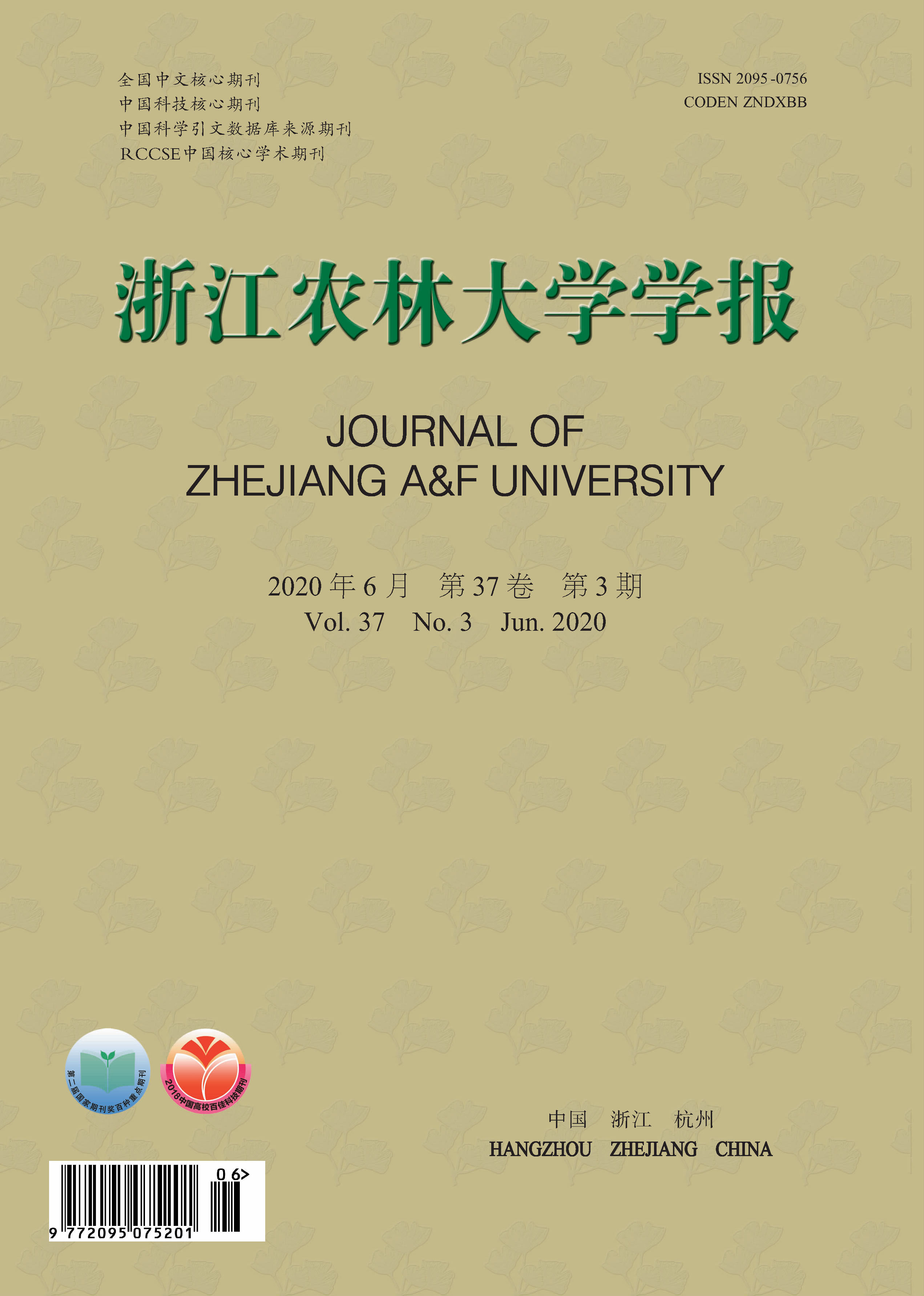







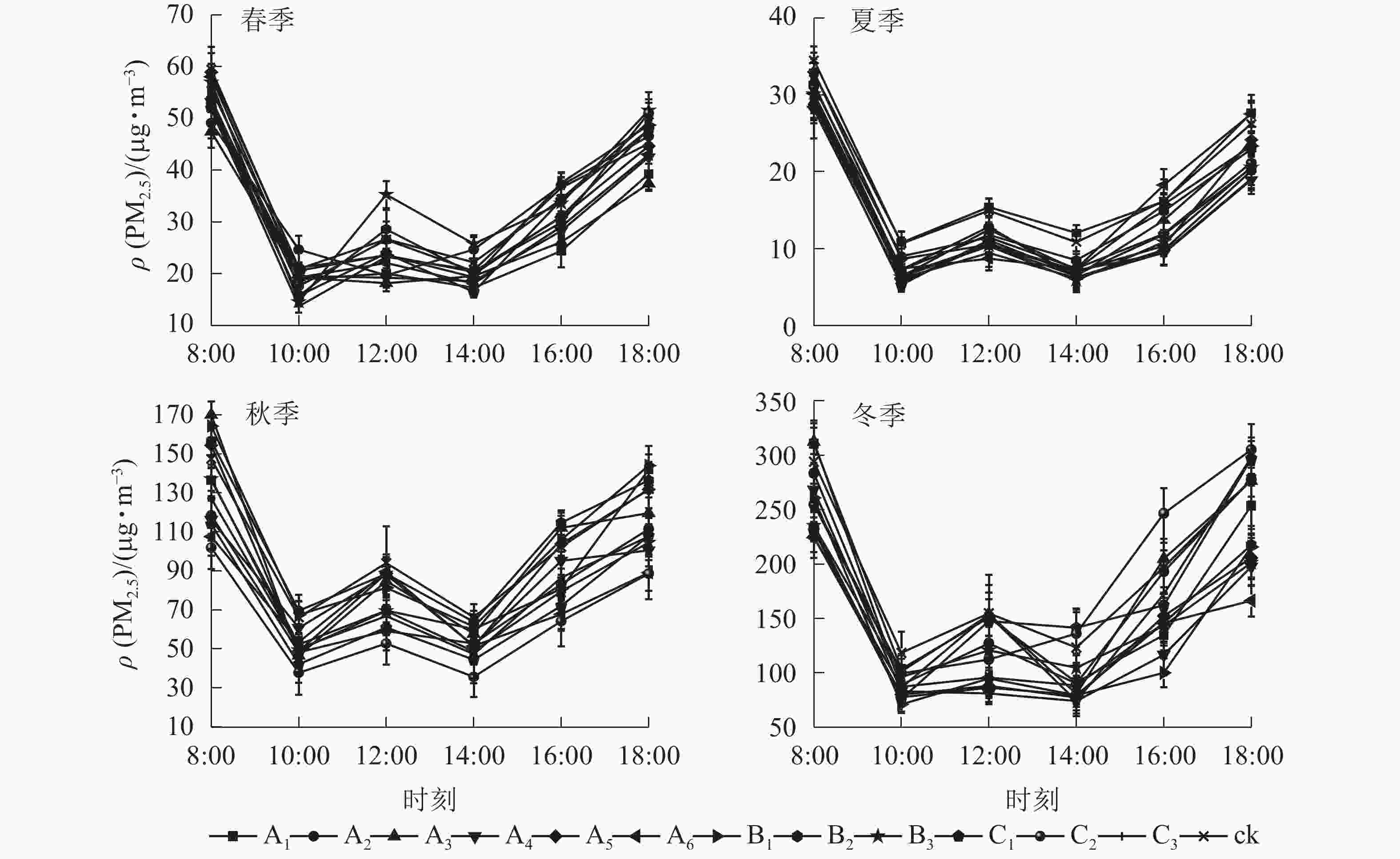
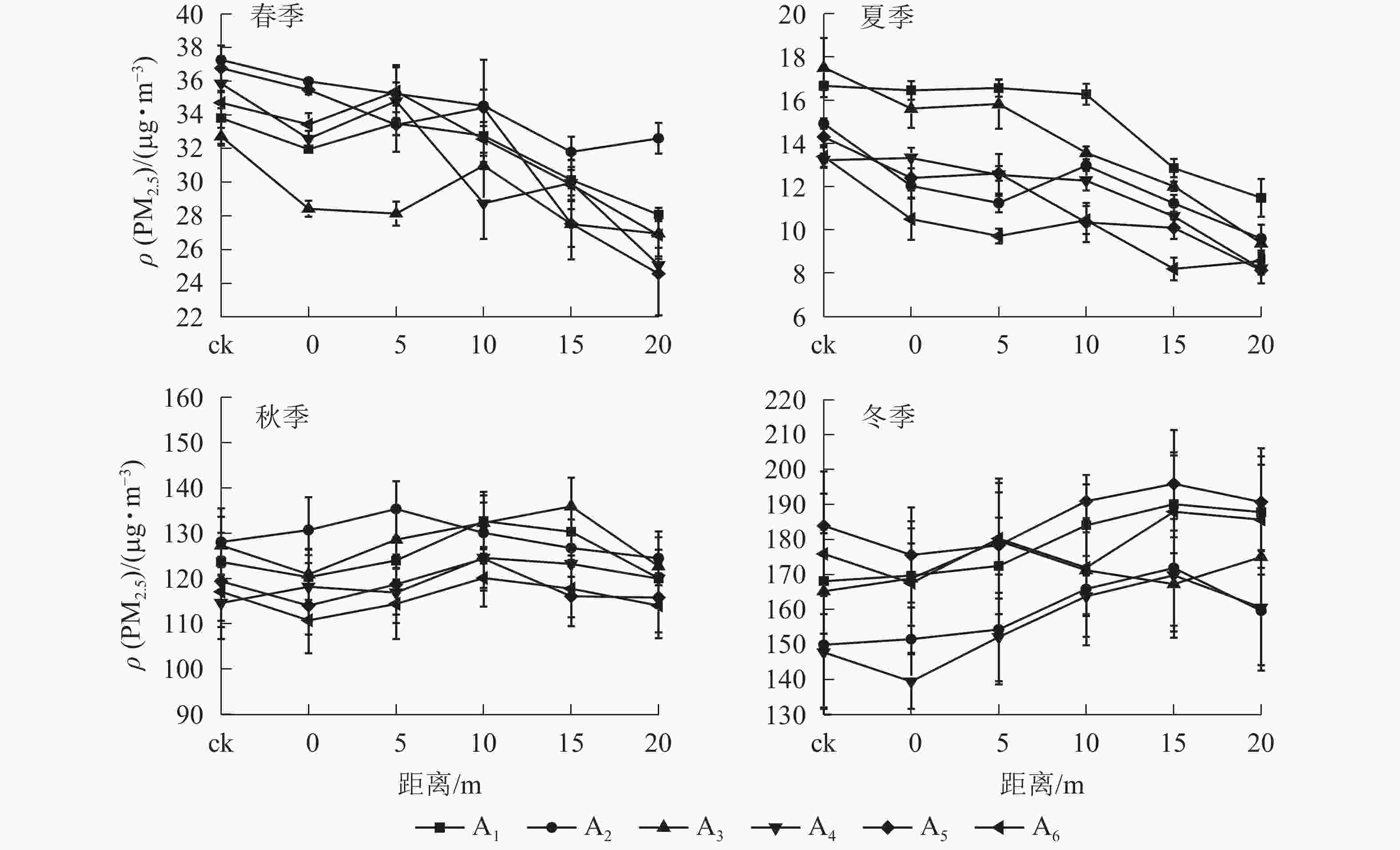
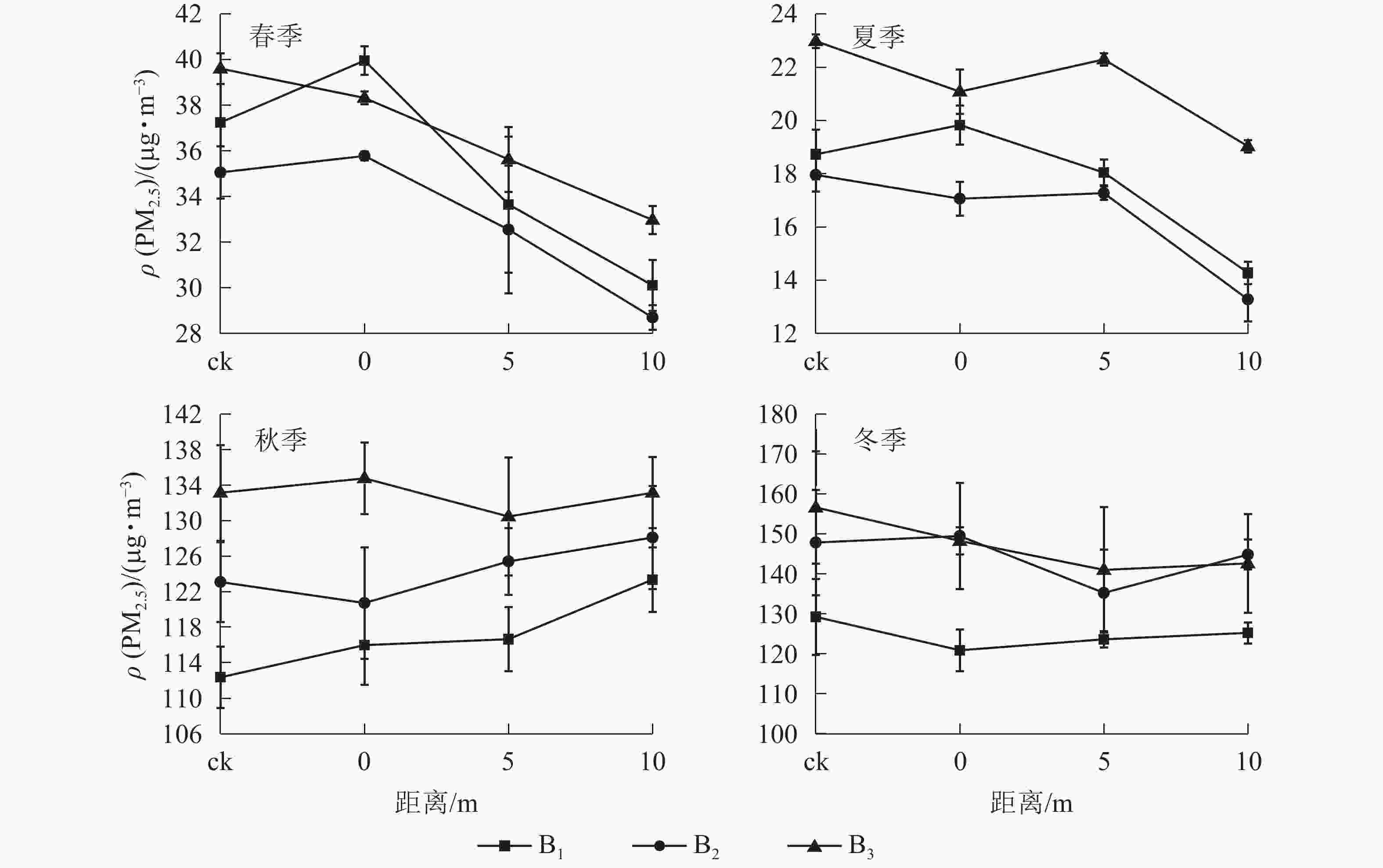
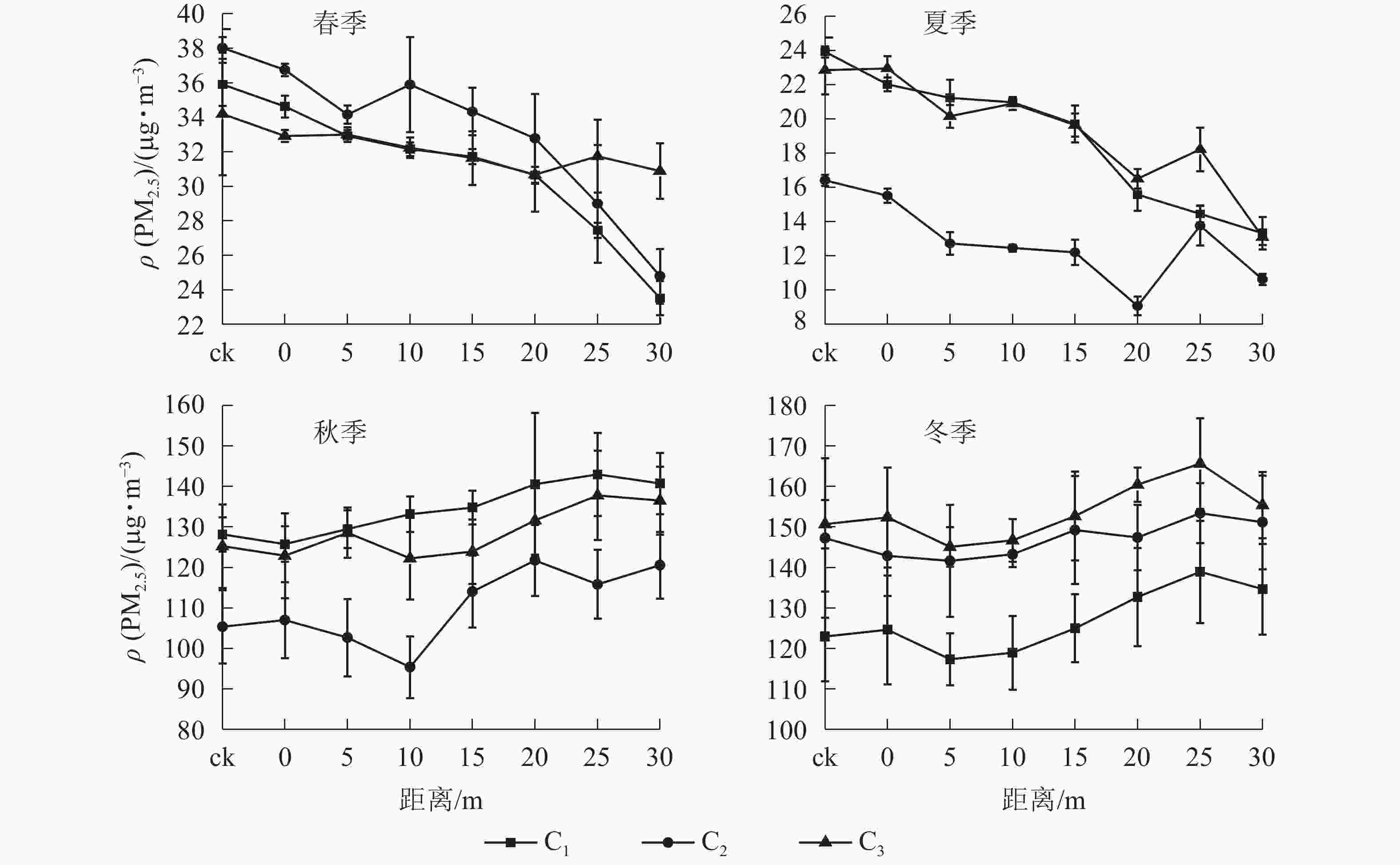
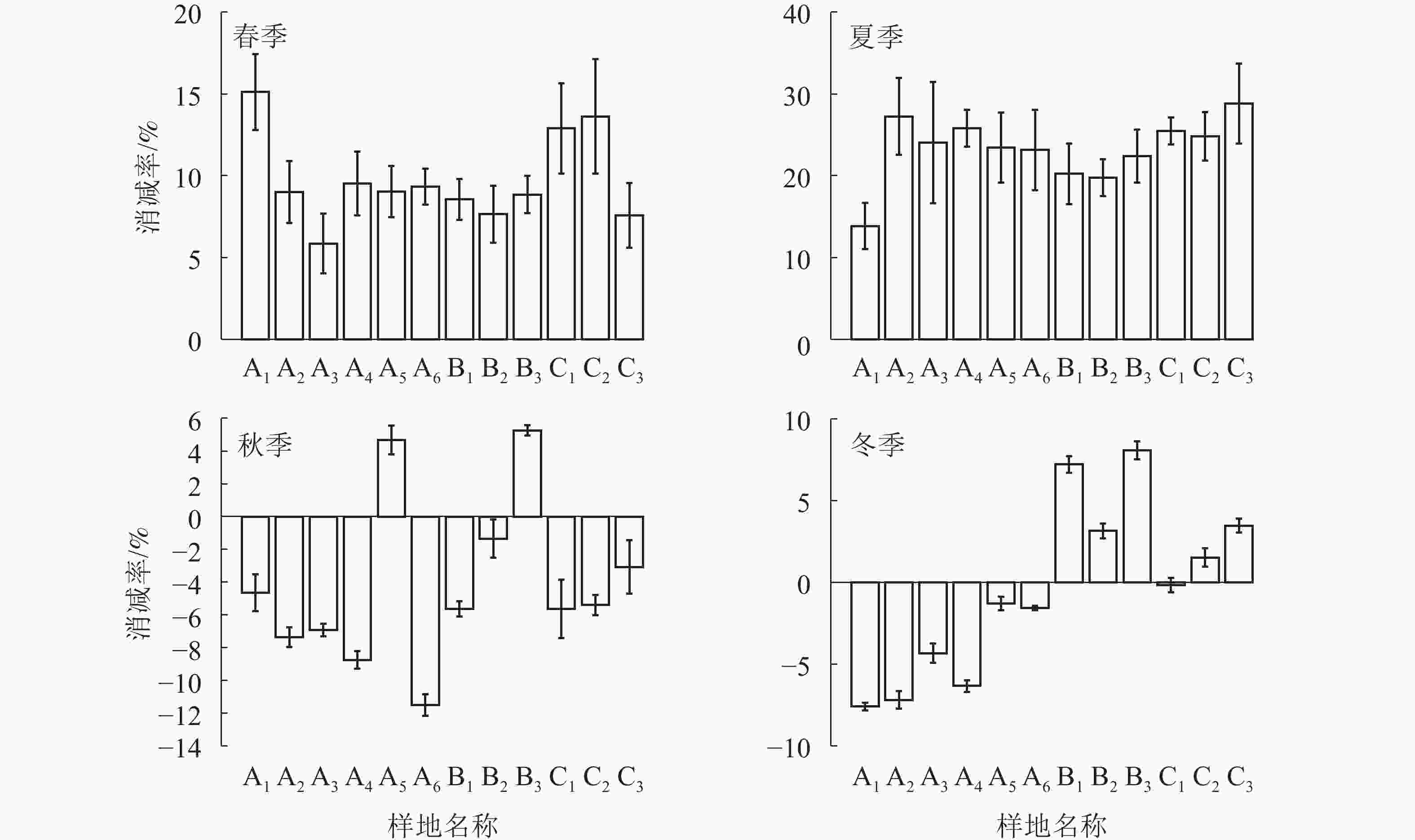
 DownLoad:
DownLoad:
